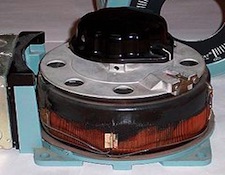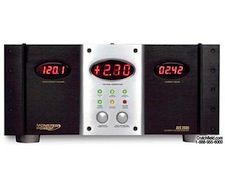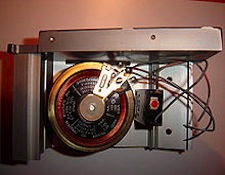It’s the time of year for saving money!

If you had an opportunity to peer into any well-equipped mid-20th
century audiophile’s equipment locker, you would most likely find a variac. And
what is a variac? It is a variable output transformer that permits adjusting AC
voltage from 0 to more than 130 volts.
My own variac is a General Radio Corporation type V10. It’s so
old that it was made before the days of three-prong AC, but still works
perfectly. Actually I have two variacs. The other is built into a Monster Power
AVS 2000. In the AVS 2000 the variac’s output is controlled by a microprocessor
designed to keep it’s output at a constant 120 Volts. I use it to control the
ac to my projector. Besides keeping the voltage constant it also shields the
projector from spikes and brown-outs.
But who, in the 21st century, really needs a variac?
If you use any tube electronics, older solid-state gear, or have equipment that
goes for more than six months at a time without being turned on, YOU need one.

I use my variac for several essential tasks. Its primary job is
to save me money. It accomplishes this by preventing me from blowing up gear. I
use my variac to power up anything that I haven’t used in a while. Instead of
flipping the on switch, I attach the component to the variac. I set the Variac
to 0 volts output, turn on the component attached to it, and then I gradually
turn the variac up to 120 volts. By doing this I spare any older or less than
fully-charged capacitors in a component from getting a nasty voltage surge,
which could cause them to fail. By gradually re-forming the capacitor, it can
be restored to a complete level without stress.
I also use my variac
whenever I first power up a piece of tube gear that hasn’t been used for a
while. Again, a gradual voltage increase saves the internal parts from the
shock of going from going from off to on. Also when I re-bias a tube component
I usually put it on the variac to insure a steady, repeatable, AC voltage
during re-biasing.

Another use for a Variac is with an audio component made for
the Japanese marketplace that has been configured for 100 volts rather than 115
or 120 AC. With a Variac you can simply dial back the voltage to 100 volts and
your Japanese-rated component will work just as it did back in Japan. Problem
solved, without going into wire-switching or transformer-swapping.
So, if you don’t already own a variac, you might want to keep
an eye out for one in your EBAY, flea market, and garage sale, travels. They
usually go for short money (because most people don’t know what they are) and
are one of those tools that every serious audiophile needs in their equipment closet.






Great advice I’ve been using a variac for years especially on older tubed gear.
Wrong. Variacs pollute the sound. Use them to revive old equipment that’s been sitting unused by bringing up the voltage slowly, but once that’s done get it out of the system.
NO KIDDING DUH!
“Pollute” the sound? Only on lower end Amps.
I use the variac just to reform the capacitor’s then remove it.
please define “gradually” with a tube amp…
Unless the tube amp is so old that it has rectifier tubes, gradually means gradually. The primary reason for using a variac is to reform any electrolytics that have lost their polarity. If the equipment has been left off for months, it could save replacing electrolytic caps and cleaning up a mess. Even if it does have tube rectifiers, they will start conducting at around 70 volts, which is usually low enough to reform the electrolytic caps safely. I used to restore old tube amps, and a variac has saved me replacing many capacitors over the years. I might add though that the variac I used was a high current model that cost a wad of money even back then.
Don’t use the monster to power your amps, it does not have enough reserve power to fully supply the amp(s).
Some do. Mine is a 2000W variac. More than enough
This article is absolutely rubbish and based on old wife’s tales. In modern equipment (with switch-mode PS’s) ou will most likely do more harm than good depending on the type. If you believe old defect capacitors will be protected by your recipe then I have a bridge to sell you.
A proper tube amplifier will have a (half voltage) glow pre-warm setting that takes care of the thermal shock you are trying to prevent with the variac. If you have some tube equipment without this pre-heat feature there could be a slight idea in using a variac – however – only use one with very low loss windings and a quality core (low hysteresis) or you will negatively impact your sound quality. High quality variacs are VERY expensive and need to be paired to the equipment so they are loaded at 60-80% of capacity to have it work as a good filter for AC spikes and noise.
This is not something I just made up – it is based on solid experience on top of a Ba and a Ma in Electrical Engineering. Don’t know what experience the author has???
The author does have a point with older equipment that hasn’t been turned on in a while, polarized electrolytic capacitors, especially the ones in older equipment, do need to be reformed by gradually bringing up the voltage. Doing so can save you replacing capacitors and having to clean up the mess when at older power supply electrolytic explodes because it shorted and overheated. Other than that, I don’t recommend using a variac , especially on modern equipment, which might have switching power supplies.. Variacs often don’t allow enough current flow for power amps, So, unless you’re in the habit of leaving your old equipment unpowered for months at a time, or you work on older equipment, I see no reason for having a variac, it’s an unnecessary expense. If you do have equipment designed for 100 Vac, or youe power line voltage runs higher than 135 Vac, I’d recommend a power line conditioner/regulator instead of a variac. You can buy a power line conditioner/regulator for around the same price as you’d pay for a high current variac.
Not so much – those dried out EC’s will die shortly anyway – you are just postponing the death a little if any.
I’ve reformed caps in very old equipment and had them last for years in regular use. If one just reforms the caps and then lets the equipment set unused again, it is likely that the old caps won’t last very long, but if the equipment is in regular use those old caps may well last a very long time.
If you got years of use out of them – good for you – BUT – they were most likely not totally dried out and might have worked fine if you had just fired up the amp the “normal” way. By working – did you actually test the capacitance of the “revived” capacitors? My guess is that you would have severely reduced capacitance and thus – while not blowing up they are not really working well and especially have severely reduced peak current capacity affecting the amp performance.
Yeah, maybe…..but that’s the point of this reply. Your opinion contains too many maybe’s in it to be taken very seriously. No offense meant. It is not simply a question of old electrolytics forgetting their factory polarity. Example: We just purchased a 1967 Fender Super Reverb. Virtually never used. Mint. Unanimous opinion in the tech shop was power supply and other polarized cap replacement regardless, before a serious run-up could begin. Experience speaks volumes, and with volume 🙂
Agreed – you are better off in a tube amp simply adding a CL-80 or CL-90 to the hot leg of your AC line. This will allow sufficient voltage through to fire up the heaters on the tubes but won’t strip the cathodes or slam the power supply with excess B+ voltage on startup. If you have a tube-rectified amplifier, then most likely you are getting that slow start-up for free. Variacs are only useful if you are trying to reform caps (to verify / test audio gear). Personally, I believe that if you are that concerned about the state of the capacitors, you are better off simply replacing them.
I repair a lot of amps, subwoofers, test equipment etc, and I always use a variac until I know no explosions will occur. Too messy. Mine is a 2000W Philco. Good variacs are in the $150 range – not too pricey, and well worth the modest cost.
I use my variac to control the temp on my slow cooker. Have also used it to control heat of a soldering iron.
It’s funny how much argument and minutia you get when discussing something like this. I’m an audio engineer and electrical engineer. Own a guitar shop among other things. We like to use variacs to bring up equipment we’re not sure of. We also use a variety of current limiters which can be used with or without the variac. The basic philosophy is in identifying and/or avoiding problems in a controlled format, thereby hopefully preventing small problems from cascading into larger ones. Some audio amps have large capacitors which can explode causing the equipment and your body much harm if it’s downstream. I’m not sure of the benefits of variac use for the average or even the audiophile amateur, but for experiment electronic shop or manufacturing labs they can be an almost indispensable tool.
Hope this idea/info helps someone to make a correct personal decision. Remember that everyone’s needs are different. They can not be generalized easily without getting into trouble. I can probably say this with conviction “Don’t buy one or use one, unless you are well versed in electrical and electronic theory”. It’s just a tool, it has it’s applications. Decide for yourself based on solid electronic theory, not on advice from an audiophile who thinks YOU should have one.
I agree with you. Amateurs probably have no use for a variac. I definitely use one as a matter of course but I am fixing and sometimes designing circuits. I also wind my own transformers and my variac is indispensable in testing. I can also sort out old but still working transformers with it, and safely.
You may visit our video on youtube https://youtu.be/x8MlqsF1nZE
https://youtu.be/qx6X4DMBQ70
A variac can only accept AC power input, but with Rectifier installed it can switch output from AC to DC.
Variac mainly used as a light dimmer, speed controller , machines for motor test and repair ,experiment machines for teaching or lab test and also industrial use.
Well, some people call it variac and others say variable transformer, we can understand from the name that it basicly used to give out constant adjustable voltage. For example single phase input 220v ,the standard output is 0-250v ,three phase input 380v output 0-430v. Please note that these are just standard output ,we can make the input and output range as your needs.
For frequency all good to use 50 or 60hz.
First let’s check out the manual adjust type, as we can see it has four terminals on the front panel ,to connect in and output cables. And also a panel meter that display the output voltage. Which we can also use LCD display. Now on the top of it we can see a black wheel, the output voltage will goes slowly up or down while we rotate it.
Here is a motor drive type, we can see terminals and meters are same but a motor on top instead of the wheel. By using this type you can connect the motor to a control box to adjust the output from distance, like you can use a 10 meters or 20 meters wire to control the variac in another room. We now have AC and DC motors for option.
Now let’s talk about the fancy motor type. Well we can see those meters display our output voltage and current. We can control the power on and off ,up and down by push button switches here. For example if we want the volt up we just press this button and when it reach the volt we can release it. The accuracy is 1 volt. Inside is the main switch control the power and coils and terminals for cable. Moreover, we install a temperature sensor inside which will cut off the power and make alarm noise when the temp. Hit 100 degrees.
For all variacs we can do max 1000kva now and we can install a rectifier to make the output switch from AC to DC.
For more information please visit our website Electric transformer manufacture or send me email : manette@junxele.com